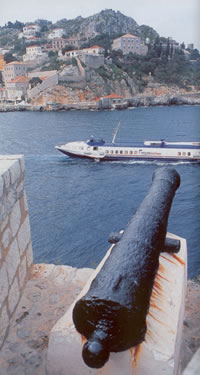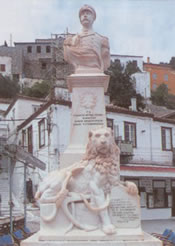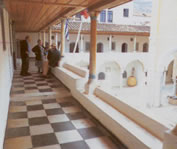 |
Greece Property for Sale - Real Estate In Greece Buy & Sell |
| Hydra Property & Houses For Sale - Real Estate In Greece 0 Property(s) Found - Page 1 of 0 - Updated: 4/25/2024 |
|
FEATURED PROPERTIES: Ikaria - Armenistis New Maisonettes Price: €209,000 - 125 m2 Bedrooms: 3 Baths: 2  |
HYDRA
Hydra's Characteristics
All the same, Hydra's unique cosmopolitan charm gives it an identity all its own, so much so that many international artists, writers and jet-setters call it home at least part of the year. Hydra's main town and port is distinguished by several large mansions and its streets by distinctive cobblestones. In past years the local population built up a large merchant fleet and many of the mansions are homes of successful ship owners. Chic boutiques and crafty stores line the limani (harbor) along with excellent restaurants serving a wide variety of international and local cuisine.
Hydra's FeaturesHydra has a land mass of 50 sq. km., 56 km. of coast and a population of about 3000 people. Piraeus is 36 miles away. Primarily hilly, rocky and barren Hydra suffers from water shortages much of the summer and water is brought in by boats towing fresh water-filled submersible rubber cylinders. Potable water is readily available in bottled form. Many of Hydras beaches are rocky and its sandier ones are organized for resorts. Caiques (small water taxis) are available to transport you to nicer swimming spots around the island–notably Mandraki. Due to Hydras close proximity to the Peloponnese it has many connections to other island locales including: Poros, Aegina, Spetses and Methana and other ports of the Peloponnese including Naufplion. Towns
Mandráki, 4 km NE of Hydra town is a small village with Hydras best beach which is comprised of small pebbles. There are facilities for windsurfing and paddle boats for hire. You can also swim near town at Bariamí Cave. Drinking and DiningThe Xeri Elia-Douskos is one of the oldest restaurants on the island and is situated in an attractive square under the trees. The Ouzerie, 'To Laikon' on the ground floor of the Merchant Marine Mansion is a traditional style watering hole renowned for its mezedes (appetizers) and before dinner clientele. History
The current glitter and glamour of Hydra originated in the 1950s when Greek painter Hadjikyriakos Ghikas pioneered an artist's colony there. Gray and white mansions were built in the 18th Century by Venetian and Genoese architects. Two of the stone-built mansions have been converted into public institutes and are available for public viewing. The town appears much as it did in the 1820s, due to careful architectural preservation. 
The church cells were a former convent and are now the town offices. Uphill from the church you find Kaló Pigádi where two 18th Century mansions were the site of deep wells that still supply the town with fresh water. Several monasteries occupy the island and are an hour or two away by donkey ride. The Monastery of the Prophet Elias and the Convent of Aghia Efpraxia being the two most notable. HintsThere are no cars or motorized vehicles allowed on the island. Donkeys and by foot are how you'll get about. If you want to stay on the island overnight, be sure you get reservations in advance. More Maps
The Complete Details
|
©2024 Real Estate in Greece.net | Contact | | Bookmark Sitemap |


 Hydra
is the third major island of the Saronic Gulf and is almost over-run by
tourists on weekends and in late summer.
Hydra
is the third major island of the Saronic Gulf and is almost over-run by
tourists on weekends and in late summer.  At night Hydra comes into its own with a vibrant taverna, bar and disco scene and many
languages can be heard. You'll have no problem making yourself understood
on Hydra but will have a problem with accommodations if you don't reserve
well in advance. There is a yacht marina on Hydra.
At night Hydra comes into its own with a vibrant taverna, bar and disco scene and many
languages can be heard. You'll have no problem making yourself understood
on Hydra but will have a problem with accommodations if you don't reserve
well in advance. There is a yacht marina on Hydra.
 Hydra Town is the only major population center. Kamíni,
2 km NE of Hydra town has a small harbor with one or two tavernas and
shops. Swimming is possible off the rocks there as well. A festival is held here on Good Friday with a candlelit procession of Christ's bier.
Hydra Town is the only major population center. Kamíni,
2 km NE of Hydra town has a small harbor with one or two tavernas and
shops. Swimming is possible off the rocks there as well. A festival is held here on Good Friday with a candlelit procession of Christ's bier.  Barren and rocky, Hydra has gone through a number of up and down cycles.
Barren and rocky, Hydra has gone through a number of up and down cycles.  The Great House of the Tsamados Family has been
converted to the School of the Merchant Marine and is the oldest such
institution in Greece. The School of Fine Art is housed in the Mansion of Emmanuel Tombazis. The Museum of Hydra holds portraits of Hydriot captains and heroes and well as paintings, model ships and weapons.
The Great House of the Tsamados Family has been
converted to the School of the Merchant Marine and is the oldest such
institution in Greece. The School of Fine Art is housed in the Mansion of Emmanuel Tombazis. The Museum of Hydra holds portraits of Hydriot captains and heroes and well as paintings, model ships and weapons.  The 18th Century church Panagía tis Theotókou has a beautiful bell tower.
The 18th Century church Panagía tis Theotókou has a beautiful bell tower. 